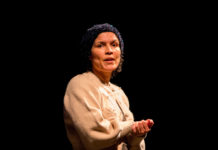
Third Space at Shaarei Tfiloh hosted the first meeting of the Inheritance Theater Project, a nine-to-12 month playmaking project with the intention of bridging community divides, on Oct. 23 in partnership with Baltimore Center Stage.
“We invite neighbors to create, rather than debate, with people who may look or pray or vote differently than they do and live in their same communities,” said Jon Adam Ross, executive director of the Inheritance Theater Project.
The nonprofit has hosted similar programs all over the United States, inviting local leaders to help lead their communities in the process. For Baltimore, local leaders who are joining the project include Rain Pryor, Antoinette Duren and Bridgette Burton.
“I’m looking forward to what the community builds together, to how the different people who hopefully will be involved will manifest this into an actual theater piece with their participation,” said Pryor, a Baltimore-based artist, writer and director.
“[Inheritance Theater Project] has come in to have a serious conversation with Baltimore, and they are really listening,” said Duren, who has worked closely with Third Space a number of times as president of the Mondawmin Neighborhood Improvement Association.
“They’re not coming in with any preconceived notions,” Duren added. “That’s why they have made it a point to take their time to be involved in the different community groups and different associations, just really trying to understand where people are and not making any assumptions.”
Each local leader has a specific role in the playmaking process. Pryor is the “process director,” and Burton is the producer. Together, they will lead and develop the project using their artistic backgrounds. Duren is the “weaver,” helping the community through the first phase of the project: community building, which Inheritance Theater Project calls “Friend Raising.”
“Our projects typically move at the speed of trust,” said Ross. “We’re usually embedded in the community for nine to 12 months, and spend that time working with different stakeholders within the [community] to engage them in a process of generating and then shaping material with themselves and then with their neighbors, and culminating in an original performance piece that is created by, with and for the community, local performers [and] local designers.”
While the organization officially describes its program as a playmaking process, Ross pushed back on that definition and said the results from their programs have been far more than just plays.
“In every city we go to, we figure out what’s the story that is emerging and what’s the best way to tell it,” Ross explained. “So, the word ‘play’ is a little restrictive, because we don’t know what it’s going to be.”
For example, he said, when the Inheritance Theater Project set up shop in Chicago, the program led to the final outcome being a house party instead of a play. In Austin, Texas, the final product was a WWE-style wrestling event with the Hispanic Dance Company, the University of Texas wrestling team and a local Jewish repertory theater.
“In Minneapolis, it was a one-man play about a hoarder that was a scavenger hunt that we performed in an antique store that closed every night at 5:30,” Ross added. “The audience would come in and secretly have all the clues, and the actor couldn’t finish the play without the audience’s help for the scavenger hunt.”
Ross said the organization’s goal isn’t to just create a play for an audience, but to invite people into the creative process: “Theater is often people in the dark watching people in the light. But when you turn the lights on and invite everybody into the storytelling process, magical things can happen.”
“Most audiences only experience art when it’s finished,” Ross added. “You see a painting on the wall of a gallery. You see a movie in a movie theater. Most artists only share their art when it’s finished. Especially in the West, artists have to commodify their art in order to make a living, and therefore share the raw version of their art less, to [not] devalue the finished version of their art.”
As the project begins to take shape, Pryor emphasized that its success depends on broad collaboration across Baltimore’s communities.
“Civic leaders, representatives in our city of Baltimore, youth, artists, poets, actors, writers, should come to the table and be a part of building this,” said Pryor. “This isn’t just a Jewish project. This isn’t just a Black project. It’s a Baltimore city project, and it’s for us to really take whatever the issues are and address them in a way that is welcoming but informative.”
Duren added that “The play is at the end, but putting the pieces together for the play, that’s where the real meat and essence are.”


